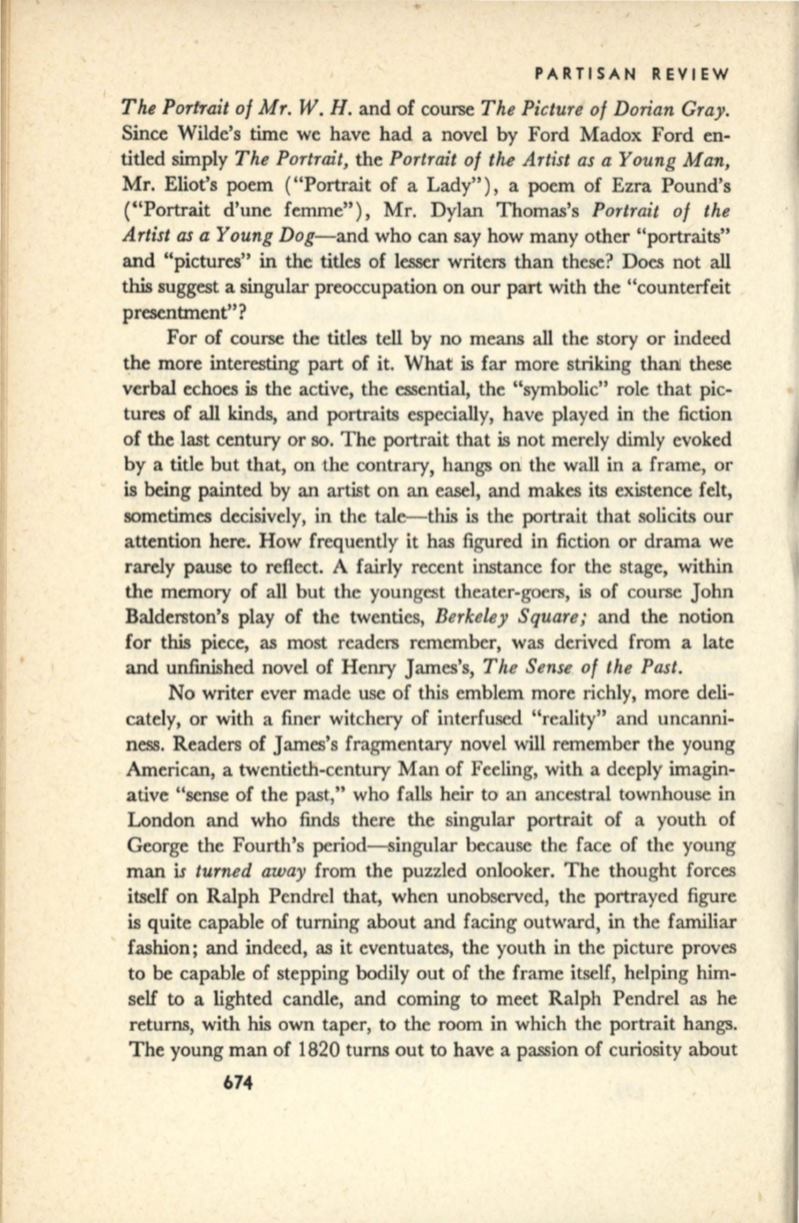
PARTISAN REVIEW
The Portrait of Mr. W. H.
and of course
The Picture of Dorian Gray.
Since Wilde's time we have had a novel by Ford Madox Ford en–
titled simply
The Portrait,
the
Portrait of the Artist as a Young Man,
Mr. Eliot's poem ("Portrait of a Lady"), a poem of Ezra Pound's
("Portrait d'une femme"), Mr. Dylan Thomas's
Portrait of the
Artist as a Young Dog- and
who can say how many other "portraits"
and "pictures" in the titles of lesser writers than these? Does not
all
this suggest a singular preoccupation on our part with the "counterfeit
presentment"?
For of course the titles tell by no means all the story or indeed
~he
more interesting part of it. What: is far more striking than! these
verbal echoes is the active, the essential, the "symbolic" role that pic–
tures of
all
kinds, and portraits especially, have played in the fiction
of the last century or so. The portrait that is not merely dimly evoked
by a title but that, on ·the contrary, hangs on the wall in a frame, or
is being painted by an artist on an easel, and makes its existence felt,
sometimes decisively, in the tale- this is the portrait that solicits our
attention here. How frequently it has figured in fiction or drama we
rarely pause to reflect. A fairly recent instance for the stage, within
the memory of
all
but the youngest theater-goers, is of course John
Balderston's play of the twenties,
Berkeley Square;
and the notion
for this piece, as most readers remember, was derived from a late
and unfinished novel of Henry James's,
The Sense. of the Past.
No writer ever made use of this emblem more richly, more deli–
cately, or with a finer witchery of interfused "reality" and uncanni–
ness. Readers of James's fragmentary novel will remember the young
American, a twentieth-century Man of Feeling, with a deeply imagin–
ative "sense of the past," who falls heir to an ancestral townhouse in
London and who
finds
there the singular portrait of a youth of
George the Fourth's period-singular because the face of the young
man
is turned away
from the puzzled onlooker. The thought forces
itself on Ralph Pendrel that, when unobserved, the portrayed figure
is
quite capable of turning about and facing outward, in the familiar
fashion; and indeed, as
it
eventuates, the youth in the picture proves
to be capable of stepping bodily out of the frame itself, helping him–
self to a lighted candle, and coming to meet Ralph Pendrel as he
returns, with his own taper, to the room in which the portrait hangs.
The young man of 1820 turns out to have a passion of curiosity about
674


